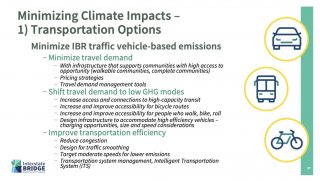Cycling News & Blog Articles
‘Climate framework’ language for Interstate Bridge Replacement project is too weak, regional officials say
Will the Columbia River Crossing project’s multibillion dollar successor fully integrate climate change into its design and construction? Or will climate change merely be a box that is checked on the way to a wider I-5 that encourages more driving and more emissions? That question took center stage at the July meeting of the Interstate Bridge Replacement project’s Executive Steering Group.
“If we’re just not increasing it, that’s not the same as reducing it.”
— Jo Ann Hardesty, Portland city commissioner
Sarah Oglier, the Principal Climate Officer for the project (which is in many ways a reboot of the CRC), presented the regional elected officials who make up the ESG with the four elements the program is placing in the ‘Climate Framework’. As you can see the in slide from Oglier’s presentation, almost all of the climate-related material focused on “minimizing” emissions
Metro Council President Lynn Peterson pushed strongest against that framing. “Minimizing isn’t good enough,” she said at the meeting. “Severely reducing is how this project is going to have to think about it.” Commissioner Jo Ann Hardesty also echoed those comments: “If we’re just not increasing it, that’s not the same as reducing it.”
Advertisement
Peterson’s comments follow a chorus of concerns raised about the project by her fellow councilors during a Metro work session in late May.
At that meeting, Metro Councilor Shirley Craddick said she sees the inclusion of climate change and bicycle and pedestrian safety in the project’s values as pushing the design to have a “much smaller footprint” than the Columbia River Crossing. Juan Carlos González, after referring to state DOTs as “black boxes of process”, said Metro can’t invest in infrastructure that “increases lanes to a point where it’s just not up to par with our regional plan.” And Mary Nolan, focusing on what she called “climate stewardship”, said she wants to see more than “weak language” around climate change mitigation. “At a minimum it should say ‘reduce greenhouse gases proportional to the billions of dollars we’re investing, potentially, in this project’,” she said.
[RELATED: Opinion: On cognitive dissonance and climate change in Cascadia]
At the July 15th ESG meeting, Commissioner Hardesty returned to an issue she’s raised repeatedly in the past; congestion pricing. “For me, I think the biggest driver in the climate impact will be congestion pricing and how that program is implemented,” she said. She pushed for more specifics on how a “climate justice lens” could be used to produce equitable outcomes and not simply shift the burden of added tolling onto already overburdened communities.
“The science of [induced demand] is unclear where you already have a corridor that’s been in use for years and years.”
— Greg Johnson, IBR Administrator
An op-ed last week by the editorial board at The Columbian called for a strong climate framework with the project, then turned around and noted that “the biggest emissions factor of the current bridge is the congestion it creates. Free-flowing traffic that allows motorists to smoothly move from one place to another will reduce travel times and help limit emissions.” Of course this completely sidesteps the issue of how an expanded I-5 across the Columbia could encourage more trips and undermine a shift to more sustainable modes that all adjacent governments say they’re trying to encourage.
Interstate Bridge Replacement Program Administrator Greg Johnson, in a forthcoming interview with BikePortland, pushed back on the idea that induced demand was a significant consideration for the I-5 project. “The science of it is unclear where you already have a corridor that’s been in use for years and years,” he said. “If we were building a new corridor, induced demand would be tremendously high on the list.” Johnson said the addition of auxiliary lanes, like the ones ODOT is currently advocating for in the Rose Quarter, will turn I-5 across the Columbia into “more of a modern structure going into the future,” but suggested that adding lanes won’t significantly impact demand for the corridor.
The project’s timeline calls for all of the aspects of the projects, including the number of auxiliary lanes and whether the project will include light rail or bus rapid transit (BRT), to be finalized by next spring — an aggressive timeline related to a desire to start construction in 2025. The climate impact of any design is sure to be fiercely debated, but it should be pretty clear before that point if things are veering as wildly off-track as many anticipate.
— Ryan Packer – This email address is being protected from spambots. You need JavaScript enabled to view it.
— Get our headlines delivered to your inbox.
— Support this independent community media outlet with a one-time contribution or monthly subscription.




